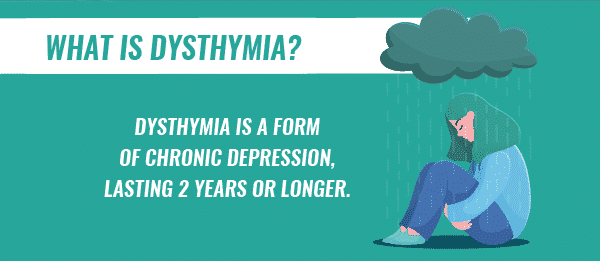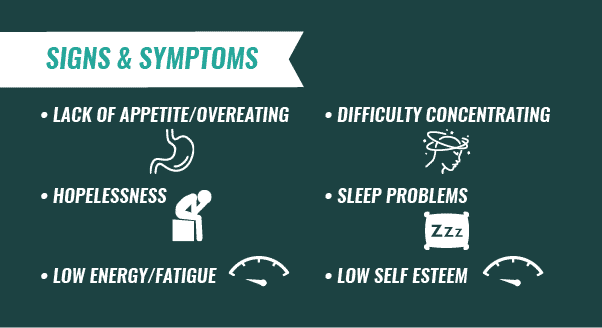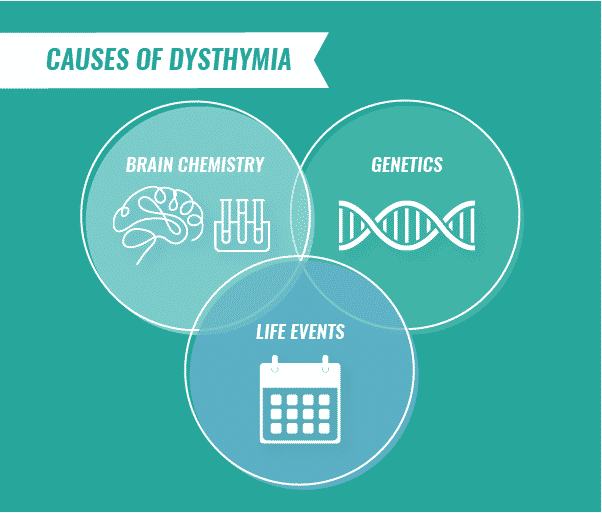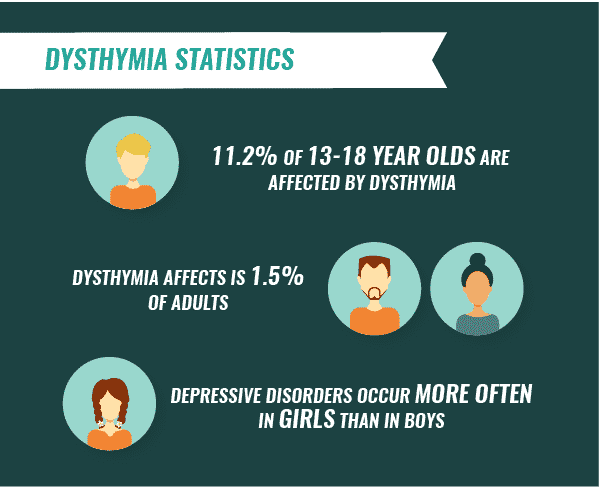Dysthymia also known as persistent depressive disorder is a chronic, less severe form of depression that can cause people to lose interest in normal daily activities.
People with dysthymia often have low self-esteem and feel down on a regular basis. They lose interest in normal daily activities, feel hopeless and lack productivity. While dysthymia is a less severe of depression, it can still have a negative impact on quality of life for those affected.
What Is Dysthymia?
Dysthymia is a form of chronic depression, also known as persistent depressive disorder. While the symptoms of this condition are similar to those associated with major depression, they tend to linger for an extended time, often lasting two years or longer. Like other types of depression, dysthymia causes continuous feelings of severe sorrow and hopelessness. The persistent feelings of sadness characteristic of dysthymia can affect a person’s mood, behavior and physical health.

Signs & Symptoms of Dysthymia
The main sign of dysthymia is the presence of depressive symptoms for more than two years. Dysthymia patients often describe their mood as consistently gloomy or flat. Other symptoms of the disorder may include:
- Lack of appetite or overeating
- Sleep problems
- Low energy or fatigue
- Low self-esteem
- Difficulty concentrating
- Hopelessness

Causes of Dysthymia
Although the exact cause of dysthymia is unknown, stress and social circumstances, like isolation and the unavailability of support, may contribute to its development. Additionally, traumatic events, the loss of a loved one, difficult relationships or stressful situations may also trigger dysthymia episodes.
Additionally, dysthymia appears to be linked to:
- Brain chemistry
- Genetics
- Environmental/life events
- Certain personality traits
- History of mental health disorders

Diagnosing Dysthymia
Before diagnosing any mental health condition, a physician will typically perform a physical examination, blood tests and additional laboratory exams to rule out the possibility of a medical condition. After no physical explanation for symptoms is found, the patient will be referred to a mental health professional, such as a therapist or psychiatrist.
Mental health professionals will ask questions to evaluate the current mental and emotional state of the patient. It’s crucial that patients answer these questions honestly so the mental health professional can make an accurate diagnosis.
The diagnosing specialist will likely use the symptoms listed in the Diagnostic and Statistical Manual of Mental Disorders (DSM-5) to diagnose dysthymia. The following symptoms must be present for two or more years in adults and one or more years in children and adolescents for a dysthymia diagnosis to be made:
- A depressed mood more days than not, that lasts for most of the day
- Undereating or overeating
- Difficulty falling asleep or staying asleep
- Poor concentration or trouble making decisions
- Low energy or fatigue
- Feelings of hopelessness
- Low self-esteem
Dysthymia Statistics
According to the National Institute of Mental Health (NIMH), dysthymia affects around 1.5 percent of adults in the United States. Approximately 49.7 percent of individuals living with dysthymia experienced severe impairment from their symptoms.
Dysthymia can also affect children and adolescents. Research from the NIMH shows depressive disorder affects roughly 11.2 percent of 13 to 18-year-olds at some point in their lives. Depressive disorders occur more often in girls than in boys.

Risk Factors for Persistent Depressive Disorder
Dysthymia often begins during early childhood, adolescence or young adulthood. Some factors may increase the risk of developing dysthymia, including:
- Having a direct relative with a depressive disorder
- Traumatic or stressful life events
- Certain personality traits that including negativity, low self-esteem, self-criticism and pessimism
- History of other mental health disorders
Dysthymia and Substance Abuse
Because dysthymia often emerges from stress, unhappiness and unresolved conflicts, people with this condition often have trouble coping on their own. It is unfortunately common for people suffering from depressive disorders, including dysthymia, to attempt to self-medicate to suppress their symptoms.
Substance abuse may provide people with dysthymia with temporary feelings of self-esteem, euphoria and normalcy. However, once the effects of the substance wear off, the negative symptoms return, sometimes more intensely. This rebound effect often causes people to use alcohol or drugs more often or in higher doses, leading to substance dependence, abuse and addiction.
Dysthymia Treatment
Due to the ongoing and unrelenting nature of dysthymia symptoms, people with this condition may feel like consistent sadness is an unavoidable part of their life. Fortunately, this isn’t necessarily true. With proper treatment, most people can find relief from their dysthymia symptoms. If you suspect that you or someone you love is living with dysthymia, it is imperative to seek treatment.
While treatment for dysthymia may vary from patient to patient depending on the severity of their symptoms, the two primary forms of care for dysthymia include medication and psychotherapy. Lifestyle changes and relaxation techniques are also recommended to improve the daily lives of people with dysthymia.
While living with dysthymia can be difficult — especially if it co-occurs with addiction — help is available. The Recovery Village has locations across the country staffed with mental health professionals who have experience working with patients with substance use and depressive disorders. To learn more, call The Recovery Village today to speak with a representative.


Greenstein. L. “Understanding Dysthymia.” National Alliance of Mental Illness. Jan. 17, 2018, Accessed December 13, 2018.
Klein, D. “Dysthymia and Chronic Depression: Introduction, Classification, Risk Factors, and Course.” Journal of Clinical Psychology. June 5, 2003, Accessed March 19, 2018.
The Recovery Village aims to improve the quality of life for people struggling with substance use or mental health disorder with fact-based content about the nature of behavioral health conditions, treatment options and their related outcomes. We publish material that is researched, cited, edited and reviewed by licensed medical professionals. The information we provide is not intended to be a substitute for professional medical advice, diagnosis or treatment. It should not be used in place of the advice of your physician or other qualified healthcare providers.